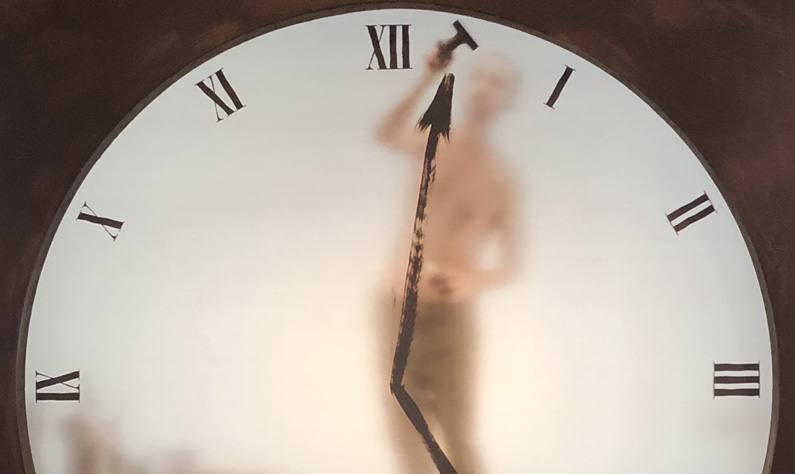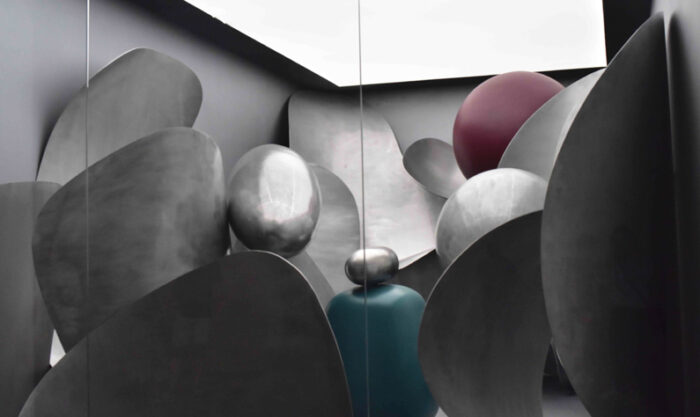Design, Idiots, Muzak and Ugly is ugly
The worlds oldest art biennale takes place in a city that is hard not to love. Despite gigantic cruise ships that regularly rape the green lagoon with erect steel hulls and harmful swells in their wake. Waves that destroy the millennia old pilings in order to provide convenience for camera wielding boat travellers. On land the novelty shops sell perverted versions of this places unique history and the tourists with their roller bags murder the calm of this usually quiet city. Fat, faraway visitors munch on greasy fake pizza and slurp one Aperol after another and chuckle idiotically after haggling on an absurd artisan glass guitar modelled after a Fender.
I am, of course, a part of the problem. With a roller bag. Despite the above description there is no better place to experience contemporary art today. For the fifteenth year in a row Quattroporte ”taints” this, perhaps most wonderful place in the world, and will continue to do so until the city tires of cruise ships and an overabundance of tourists and perishes in finest Atlantis fashion.
The 58th art biennale in Venice has been given the name May You Live In Interesting Times and is curated by Ralph Rugoff, head of Hayward Gallery in London. He means that we live in a challenging time and that art should be used as a way of exposing the true core of the present. The idea lacks originality and represents a pretentious-lackadaisical attitude that aims at depth but instead tends toward shallow and kitschy programmatic banner art.
The point of our yearly visits to the Venice biennale is to better understand the flows in society that are often hinted at in contemporary art. Beyond the artists own story. Beyond the curators strivings. Beyond intentions.
Even if we feel that May You Live In Interesting Times sets a low bar and is at times quite ugly, it is still relevant. The art is showing us a future that we may not want at all, that is, a sloppy, repulsive and unaesthetic future. But what else could the future be when the world, according to many, is facing impending doom? Anthropocene, global climate crisis, migration crisis and post-truth are just examples, so art can hardly be more than a filthy vessel, seems to be what Rugoff is telling us.
The problem stems from the point of view that the curator provides for the artists to work with, creating a narrow ideological lens that hinders and impairs the possibility of creating a narrative beyond the intentions. Rem Koolhaas curated the architecture biennale 2016 that became a festival of utter deconstruction, effectively murdering all brilliance. This years’ biennale tends toward this kind of destructive over-ambition.
The designer creates art
One of the most interesting exhibitions we visited was not part of the Biennales’ regular programme and was not created by artists but only by designers. It was in the fabulously beautiful palace Galleria Giorgio Franchetti alla Ca’d’Oro that 23 of the most significant designers of our times exhibited great art. There were, for example, marble creations by Mathieu Lehanneur, creations stylising ocean waves using marble tables and low colonnades in the piece Ocean Memories, dreamlike Inside A Forest Cloud by Cacho Carbonaro and Virgil Abloh with Acqua Alta. All examples of how organic design is taken to the next level in the creation of pieces that feel both ancient and at the same time prophetic. The pieces seem to flip you off and say that they are here to stay, whereas you are only visiting. This is probably true. I believe that many of the pieces exhibited in Ca’d’Oro will live for centuries. Perhaps this indicates that the gap between design and art has never been smaller, and that the next Jeff Koons or Andy Warhol could be found among the young designers of tomorrow.
The idiot as the true man
Irmgard Speck became 104 years old and for 97 of these years she spent 10-12 hours a day at her spinning wheel. Completely uninterested in the outside world she spun through two world wars, 400 000 kilometres of yarn; more than the distance between the earth and the moon.
Those who refuse to give up on their passion, their craft and their calling easily become obsolete in a modernist context. An individual who shuns the world and refuses to follow trends is often considered an idiot. The Belgian pavillion and Mondo Cane showcases a number of these overenthusiastic ”idiots”. Those who will not fall in line. Who are their own person. A human who doesn’t multi task, who learns something from the basics and perhaps becomes a master. Someone who has never used Google becomes the true man. We see a reality beyond the data, digitisation and deep humanism can be glimpsed. Who dares to think further than AI, smart speakers and big data? Or maybe just look up for a second from their smart phones.
Muzak in fashion
Perhaps music has never been valued lower than it is today, now that everything is so accessible; Mozart, Cardi B and Harry Brandelius. Available for pennies. Music is being used as a free enhancer of mood in the contemporary art at this year’s Venice biennale. We experienced this, for example, in Australia’s exhibit Assembly. The idea was fair but the music was mediocre.
This years Golden lion was won by Lithuania’s Sun&Beach. A performance-opera about global warming. Nice performance but hardly a musical experience. Disgusting minimalism: Dm-C-major for twenty minutes is an insult, possibly not to a tone deaf and politically cowardly art jury. Of course the case can be made that the topic is incendiary and that the music gathered inspiration in traditional folk music, but this hardly excuses paltry Philip Glass plagiarism. A bit like plagiarising Gyllene Tider. Where have the musical ambitions gone?
Added to this are all the film installations accompanied by a low pedal tone often using a G for some reason to create a threatening-mysterious ambience. Childish. Music is turning into meaningless Muzak, without purpose and meaning except for adding colour and setting a mood. Muzak is here to stay. Bummer, for real composers and musicians. Music has been sent to the corner for a time-out.
Ugly is not the new beautiful
It has been said that beauty is entirely subjective and as such influenced by trends and cultural conventions. Beauty can in other words be ugly and vice versa. At this years biennale, however, it is abundantly clear that ugly is ugly and beauty is beautiful. The beautiful engages, as with Tomàs Saracenos Aero(s)cene and Mathieu Lehanneur in Ocean Memories. Perhaps the idea of the eternally beautiful and generally visually pleasing becomes increasingly important and more aligned with the radical and the current. A counterweight to a zeitgeist where negative news and our swiftly impending demise has developed into a self-fulfilling prophecy.
Leaving Venice and the biennale is always associated with a certain measure of pain. Almost existential in nature. When we see Guidecca disappearing in the distance I find myself yearning to return again. Perhaps I am a hardened addict of art, but above all I am in love with this now all to obviously sinking city.


